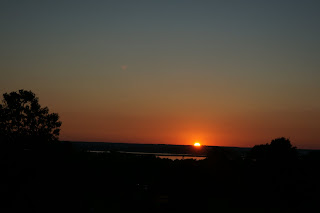
In 1839 when the Mormons arrived at the place in Illinois they eventually named Nauvoo, it was a small town called Commerce. They bought the site in 1840 and renamed it Nauvoo. They Mormons cleared land between the Mississippi river and the hill or bluff upon which they built a Temple. The land east of the bluff was very flat. In 1844 there were 15,000 people in Nauvoo, making it the second largest city in Illinois. It was not a typical frontier settlement. There were many craftsmen, tradesmen, etc. in Nauvoo. Many converts to Mormonism from England, Canada and the eastern United States settled there and plied their trade. Consequently there was not much need for outside goods which was one of the sore points with others in the area. The other Illinois residents were also afraid of them voting as a block.
The photograph below shows a section of prairie in Nauvoo that has been restored to its original state. The woman in the photo is about five feet two in height.

Below is a photograph of the Mansion House. It was used at various times as a home for Joseph and Emma Smith and as a hotel.

The handsome red brick home below is Brigham Young's home. The red brick is typical of locally made brick and is sometimes known as "Nauvoo red brick."

The small building below is a boot and shoe shop owned by a man from Germany named Riser. It also served as the family home.

This is inside the shop and shows a number of lasts on the wall along with other items related to the shoemaker's trade.

This photo shows a tool used to cut heels from leather. The cut pieces were then stacked together until the correct heel height was obtained. You can also see a bin of wooden pegs used to attach the sole, as well as a bin of small brads.

Below is a view of the Smith family cemetery, literally on the bank of the Mississippi. Joseph's father and mother, his wife Emma and his brother Hyrum are all buried here.

Blacksmith at work.

This is a stock used to support an ox while it is being shod. Unlike horses, oxen cannot support themselves on three legs, so the stock is necessary to keep them upright while the farrier shoes them.

I may be wrong but I believe that below is a photo of the only ceramic defecatorium I have ever seen, although they are fabled in song and story.

Below is John Browning's house and shop. John Browning was a gunsmith as well as blacksmith.At this time(1844) he was making regular guns as well as slide guns, which were a repeating rifle in which a clip fed in rounds from the side as opposed to vertically. The clip held up to 25 rounds. John and his family traveled to Utah with the rest of the saints and established the Browning gun works in the Ogden--Morgan area. His son, John Moses Browning, was a firearms genius. He developed the Browning light machine gun, still used by armies around the world, the US Army .45 pistol(sold the rights to Colt), most if not all the machine guns used on US aircraft in WWII, the Browning Automatic Rifle(BAR)used extensively by US infantry in WWII and Korea, and many other innovations. Browning Arms are still associated with quality and innovation.

This rocking horse was the prized possession of John Taylor's small boy at the time they were forced out of Nauvoo. With a limited ability to take necessities, the rocking horse was left behind when they crossed the Mississippi. The boy was inconsolable, and his father returned to Nauvoo and brought the rocking horse to the boy. It made it all the way to Salt Lake City, and was eventually returned to Nauvoo by the Taylor family.

This is the landing at the foot of Parley Street. It was here that boats landed and from here that the Mormons crossed the Mississippi to Montrose, Iowa when they were forced to leave Nauvoo. They began leaving in February, 1846, driving teams and wagons across the river on the ice.

When the ice melted they crossed the river on ferries, such as the one shown below.

Nauvoo from Montrose, Iowa with the Temple prominent on the bluff. This is what the Mormons last view of Nauvoo would have been.














